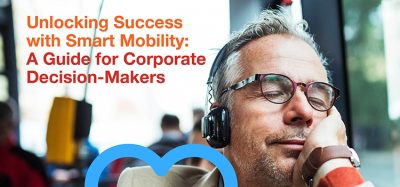Creating a smarter and more sustainable city: The role of artificial intelligence and open data
- Like
- Digg
- Del
- Tumblr
- VKontakte
- Buffer
- Love This
- Odnoklassniki
- Meneame
- Blogger
- Amazon
- Yahoo Mail
- Gmail
- AOL
- Newsvine
- HackerNews
- Evernote
- MySpace
- Mail.ru
- Viadeo
- Line
- Comments
- Yummly
- SMS
- Viber
- Telegram
- Subscribe
- Skype
- Facebook Messenger
- Kakao
- LiveJournal
- Yammer
- Edgar
- Fintel
- Mix
- Instapaper
- Copy Link
Posted: 25 April 2023 | Angelos Chronis - AIT Austrian Institute of Technology | No comments yet
Angelos Chronis, Head of the City Intelligence Lab at the AIT Austrian Institute of Technology (AIT), sat down with Intelligent Transport’s Leah Hockley to discuss the role of new digital technologies in supporting intelligent and interactive decision making, and shared exclusive insight into his work with artificial intelligence and open data that is contributing to the development of a holistic model of a city.
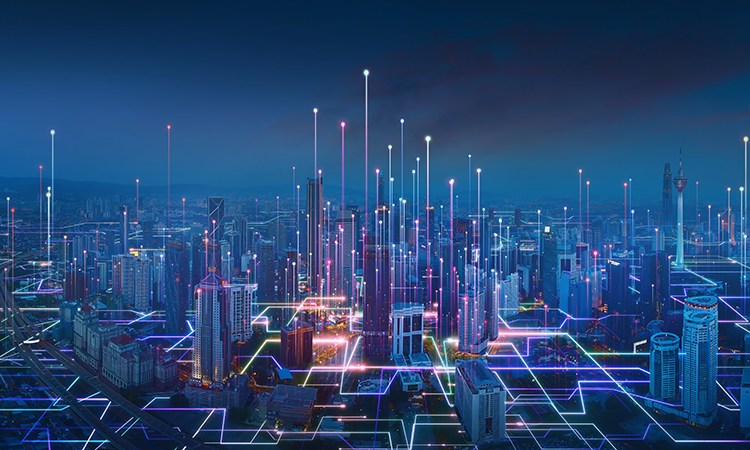

Can you share some insight into the City Intelligence Lab and how it supports the transport industry in achieving a smarter and more sustainable mobility network?
The City Intelligence Lab is essentially an innovation hub within the Digital Resilient Cities unit at the Center for Energy of the AIT Austrian Institute of Technology – the largest non-university research organisation in the country. Within the Digital Resilient Cities’ unit, we have different research fields, like smart and carbon-neutral urban development, energy supply, mobility, transportation and climate models.
The City Intelligence Lab is essentially trying to foster novel technologies, digital technologies and cutting edge technologies – like artificial intelligence (AI) or augmented reality (AR) – to really bring together all of the disciplines into one intelligent and interactive decision support framework, which allows planners, municipalities, developers and transport planners to co-ordinate the city’s urban development in one integrated model. Through the City Intelligence Lab, we want to combine the different disciplines and expertise in one integrated model/ framework.
A city is a very complex network, which consists of the movement of both people and goods, in addition to urban features, such as greenery and transport. As such, everything has an impact on something else. For example, land use affects transport use, transport use affects the climate and the climate affects land use – it’s all connected.
What we want to achieve is a holistic model of the city, and we believe that, by having an expansive data reach and ‘intelligent’ models of the city, we can really change the way that we make decisions”
Therefore, what we want to achieve is a holistic model of the city, and we believe that, by having an expansive data reach and ‘intelligent’ models of the city, we can really change the way that we make decisions. For example, every time that we pedestrianise a street, we are not only affecting the movement of people, but we are also affecting traffic, the climate and the retail use of the street. There’s a whole bunch of things that are affected by just one pedestrianisation in one part of the street. Thus, having a way to look at the impact in one holistic model will allow us to make more accurate decisions, after looking at every potential decision and the impact that it can have on all of the different components.
So, in terms of mobility and sustainable mobility, the one thing that is often difficult to grasp is how behavioural changes and societal changes within mobility are actually affected by all of the other parameters. In that regard, what we’re trying to do is really working to bring everything together – which is where, I think, is our biggest contribution.
Why do you think it is important to embrace innovative technologies – such as artificial intelligence – when designing services that foster sustainable urban transport?
As I was saying, a city is a very complex model. Of course, we have different disciplines. Transport planners are different in comparison to urban designers, city planners and policymakers. Everyone has their own silo and expertise. The problem is how to break these silos.
The biggest challenge is that there’s a lot of data collected about the city, but it is very fragmented and not unified. There’s not enough overlap between the disciplines to be able to understand the impact from all of the different sides. In that sense, the idea of AI and data-driven planning, or intelligent impact assessment, helps to break these silos, as they provide a holistic or unified model that allows us to understand impact in various disciplines.
The idea of AI and data-driven planning, or intelligent impact assessment, helps to break these silos, as they provide a holistic or unified model that allows us to understand impact in various disciplines”
Therefore, AI is really important, because humans, despite being very intelligent, are often slow at doing things. On the other hand, computers may not be as smart, but they are very fast in doing things. This is why we are also using AI for simulation prediction, in addition to other things, in order to use these models to make the life of decision makers easier, so that we don’t have to wait for a week to calculate certain things.
This also means that we don’t have to create a communication burden between stakeholders every time that we make a decision. For example, when talking about sustainable transport, it involves changing the way that we move around in a city, which ultimately affects a lot of different stakeholders and components. So, in order to be able to understand that, we all need to sit down at the table and change things, while looking at the impact. This is why we are really focusing on making this information much more available and accessible.
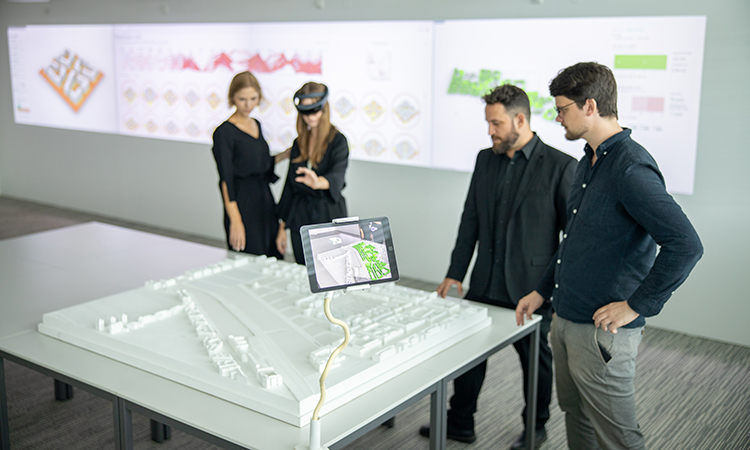

Credit: AIT Austrian Institute of Technology
You spoke about this briefly already, but how else does data contribute when carrying out research at the City Intelligence Lab?
I think data is a hugely important topic. Often, when we talk about urban data or data collection, most people think that they’re always being watched in everything that they do online. However, that’s just a very small aspect of what we are monitoring in the world.
Every moment, we have tonnes of data going around the city about everything we do, how we move, how we use transport, how the air moves, how the climate behaves – everything is monitored. There are two problems with this. The first is that the data’s not ever really available, mainly because the data is sometimes monetised, and that’s why we’re talking about our online behaviour. The second challenge is that, although there’s so much more data that is readily available, it’s not really unified. So, we are working a lot with open data. Vienna is a great example of that, as it has a really nice open access data platform. We can get a lot of data about the city, from where the trees are to where benches are to how things are being used, demographics, etc.
Essentially, if you have enough data, you have a multi-layered representation of the world that shows you activity, movement, the climate, energy and environmental conditions, all in one model”
Essentially, if you have enough data, you have a multi-layered representation of the world that shows you activity, movement, the climate, energy and environmental conditions, all in one model. This means that, with the use of AI, if I today can understand what you’re going to buy next just by looking at what you like on your social media profiles, imagine how much more information I can have about how the city is used and how I can make this more sustainable and efficient.
Thus, it’s fundamental to use data, and it’s also fundamental to have open data, and it’s even more crucial to create the channels of communication between the different disciplines – going back to this multi-disciplinary idea – in order to be able to exchange this data. One of the things that we do in the lab, for example, is to try to develop a common data scheme for all of our researchers in the unit, as well as everybody who’s externally using our work, to really bring all of the data together, in order to be able to search through the data to understand the patterns of movement and the patterns of activity.
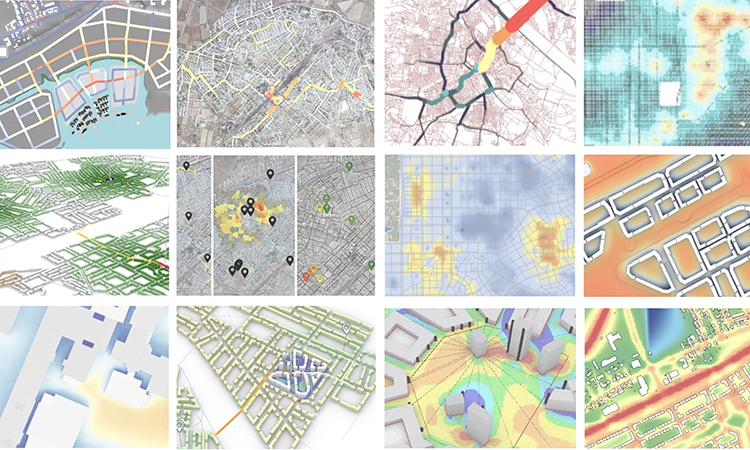

Credit: AIT Austrian Institute of Technology – CIL analyses and simulations.
In 2021, the City Intelligent Lab’s Intelligent Framework for Resilient Design (InFraReD) was nominated for the National Award for Mobility. What makes this platform unique and how can it be utilised to support the realisation of ‘smart cities’?
We are quite proud of InFraReD and our award nomination. We have also won a couple of other awards, and we’re now trying to find a way to bring InFraReD forward and make it more accessible to a wider range of people, so there will, hopefully, be more news on the next steps of InFraReD very soon. What makes this project really unique is exactly what I mentioned before, which is the use of AI and AI models for sustainable urban planning.
When we’re talking about AI, we often think about online data, or other sorts of mobility. In our case, AI is focused on the InFraReD side, on making this simulation information, or prediction of environmental or other conditions, more accessible.
The best example, perhaps, is to look at wind comfort or wind speed prediction. If someone wants to do a simulation of how the wind moves around a certain area, when a new building is being built or when creating a new urban layout, a computational fluid dynamic simulation needs to be run, which is a very well known, notoriously slow simulation. It can take up to one day to run just one scenario for the urban scale. And the example that I’m referring to is a smaller street area.
InFraReD can predict the same simulation result in one second. We’ve done this through deep learning and using really advanced AI models”
However, InFraReD can predict the same simulation result in one second. We’ve done this through deep learning and using really advanced AI models. We’ve trained them with thousands and thousands of simulations that we have run, which is how we’re able to predict the simulations in a second. What we are aiming to do is continue developing models for transport noise and other sort of models based on other aspects of the city to really go back to this idea of having readily available information for planners, designers, transport, mobility, city planners, etc.
We’ve used InFraReD in many situations – for example, planning new areas or developments, like high rise buildings, and identifying how they affect wind. But there’s also uses of InFraReD that are much more innovative. For example, we have conducted a study with a couple of students from the Institute of Advanced Architecture of Catalonia, where we took the streets of Vienna and ran wind simulations for the main wind directions of the year. After this, we created a bike routing app, which essentially allows the user to find ways to avoid wind when moving around on a bike. So, that’s another way of seeing it.
Again, this is something that is not really possible if we cannot conduct simulations in such a fast way. It’s not exactly the same as doing a simulation. It’s 90% or so accurate, but it’s really ground-breaking in the way that we can use simulations and analysis. That’s exactly what we’re focusing on, bringing back the climate and the environmental conditions in the design process as a tool to design with.
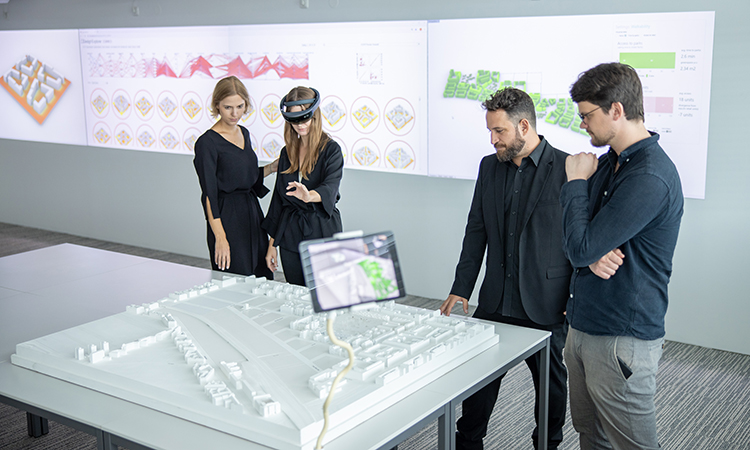

Credit: AIT Austrian Institute of Technology
What piece of research are you most excited about that the City Intelligent Lab is currently conducting?
The main focus of the lab… is this idea of a unified, holistic model of a city: being able to have different layers of very diverse data, and very diverse models that are connected in the same holistic model”
Well, I would have to say InFraReD for that. We are definitely really, really proud of InFraReD. I think that this project has been our most well received – it’s been published a lot, and it’s achieved a lot of awards. But, at the same time, the main focus of the lab, and what we are aiming to do also in the future, is this idea of a unified, holistic model of a city: being able to have different layers of very diverse data, and very diverse models that are connected in the same holistic model, and therefore breaking the silos of the different disciplines. This would allow planners and researchers to really go in between the different disciplines extremely fast.
This is something that we are trying to do in the future by building a sort of dashboard of the city, which would allow us to select a point – an area plot or a street – and look at everything that relates to this street, from the climate to the greenery to the transport to the movement of people, the point of interest, or even social media. There’s so much data that you can have for one point of the city and, in most cases, we do not have a unified model of that, so this idea is perhaps a future idea that we are working on.
Looking to the future, what innovative technologies do you hope to see become more commonplace and more widely implemented across the transport industry, but also smart cities as a whole?
This is a tough question. I am a big advocate of AI and urban data, and I’ve been teaching AI models and algorithms for almost 13 or 14 years now. Before the big boom of machine learning (ML) and other new models, AI wasn’t really such a big topic. I think we haven’t even glimpsed upon the changes that we can have in cities when we manage to leverage the use of this data and AI. The vast amount of information that we can collect about cities and then use to make cities better is completely astonishing.
Understanding the patterns of people movement, environmental conditions, transport networks, economic activity and demographics all in one holistic approach is what really makes a difference”
We are all talking about city and urban data. Urban data is more like a common good. It’s not our personal behaviour online and that data that could really make a significant change in how we can make our cities more sustainable. Understanding the patterns of people movement, environmental conditions, transport networks, economic activity and demographics all in one holistic approach is what really makes a difference. Also, I think that each one of us has our own little perspective on what data we care about or what data we need – we have our own standards. I believe that, when we start unifying that, we will see a huge change in how we plan and use our cities with data.
The funny thing about AI is that all of the machine learning models that we use today, all of these big models, are produced by large tech companies, and they’re given out for free as open source models. In the machine learning and AI community, it’s very common that people just publish their models. There’s a very fundamental reason as to why people publish their models, as the monetisation is not on the models themselves, but it’s on the data.
So, social media or other online tech companies have their own data that they use and try to understand our pattern of online activity with. These models, when applied in the city of Vienna, for example, can produce incredible results. Overall, in five years time, I think we’ll see a huge jump in the utilisation of AI models and urban data. I think that would also be my hope.
Is there anything else that you would like to share with our readers today?
I would like to highlight the importance of this transformation. It’s not just to do with urban mobility, but it’s also about general city planning and urban development. It’s about communities”
One last thing I would like to highlight is the importance of this transformation. It’s not just to do with urban mobility, but it’s also about general city planning and urban development. It’s about communities. So, what I think we really urgently need is to build communities, such as the AI communities of urban development, for example. I am already actively involved in a few of them, and I think we need to really push more.
So, I think what you’re doing also in your work with Intelligent Transport is really important in bringing people together and creating communities. So, I think community building will essentially consist of the data scientists, planners, urban data experts of the future. If we don’t create communities to talk to each other, then we won’t have a way to exchange our knowledge and findings. Thus, community building is really significant.


Related cities
Vienna
Related countries
Austria
Related organisations
AIT Austrian Institute of Technology
Related people
Angelos Chronis






